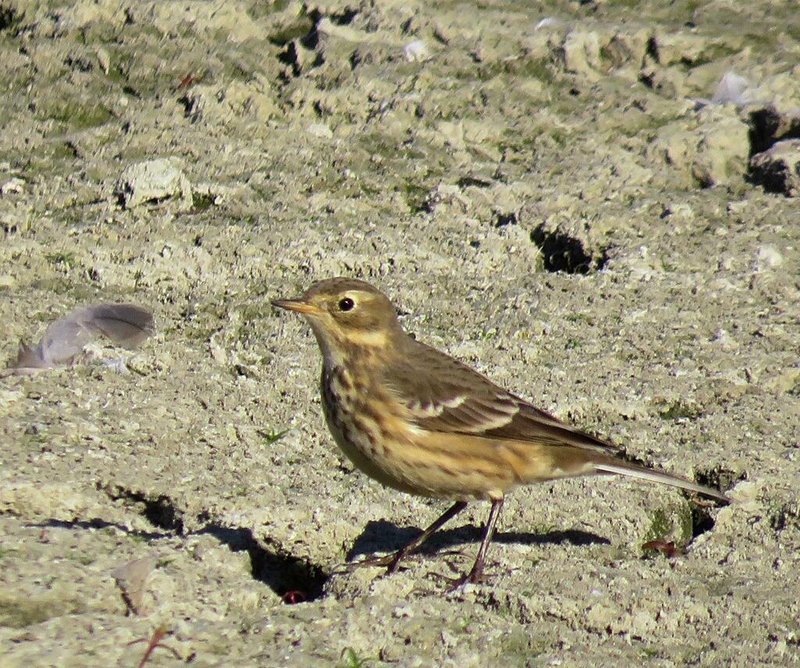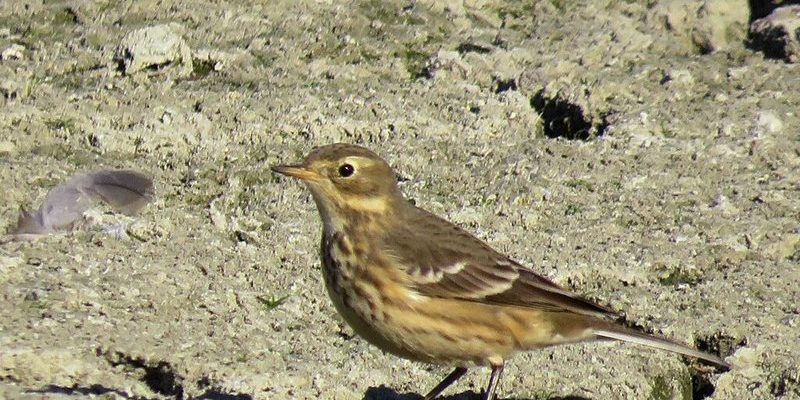
When you hear the word Pipit, you might picture a small bird flitting about in the grasslands or singing sweet melodies in the early morning light. These delightful birds belong to the family Motacillidae and are often recognized by their slender bodies and long legs. They can be quite elusive, often blending into their surroundings, which makes spotting them in the wild a thrilling experience for bird watchers.
Pipits are found across various regions, from open fields to coastal areas. They’re known for their charming songs and distinctive behaviors, such as their characteristic ‘pip-pip’ calls that give them their name. Think of them as the little entertainers of the avian world—always ready to perform their tunes whenever the mood strikes.
If you’re curious about how these birds live, what they eat, and their unique behaviors, then you’re in for a treat. Let’s dive into the wonderful world of Pipits and uncover what makes them so special!
Physical Characteristics
Pipits are typically small to medium-sized birds, averaging about 7 to 9 inches in length. They have a slim build, which gives them an elegant appearance as they hop and flutter around their habitats. Their plumage varies by species but usually features a mix of browns, grays, and whites, allowing them to camouflage beautifully with the grass and soil they frequent.
A key feature to note is their long legs, which help them navigate through various terrains with ease. It’s like having a built-in pair of stilts that allows them to run swiftly across the ground, which is essential for evading predators. Their wings are also long and pointed, making them agile flyers as they dart between bushes and trees.
Here’s a quick overview of some interesting physical traits of Pipits:
| Size: | 7 to 9 inches (about 18 to 23 cm) |
| Weight: | 0.7 to 2.5 ounces (20 to 70 grams) |
| Coloration: | Brown, gray, or white with streaks |
| Wingspan: | Approximately 12 to 15 inches (30 to 38 cm) |
Habitat and Distribution
Pipits are quite adaptable when it comes to their habitat preferences. They can be found in a range of environments, including grasslands, savannas, and even wetlands. These birds thrive in open areas where they can forage for insects and seeds, their primary food sources.
You’ll often spot Pipits in fields or alongside agricultural lands, where they can roam freely and find plenty of tasty treats. Some species even inhabit coastal areas, taking advantage of the rich food sources found near shorelines. It’s fascinating how these birds have carved out niches for themselves in various ecosystems!
Geographically, Pipits are distributed across many parts of the world. Some species migrate seasonally, moving from breeding grounds in northern regions to warmer areas during the winter months. This migratory behavior means that depending on the time of year, you might see different Pipit species in your area.
Diet and Feeding Habits
Pipits are primarily insectivorous, meaning they feast on a diet rich in insects like crickets, beetles, and ants. They also enjoy seeds and berries, especially during the colder months when insects are less abundant. Observing these birds forage can be quite entertaining; they often run on the ground or hop around in a rhythmic fashion, searching for food.
When foraging, Pipits use their keen eyesight to spot food from a distance. They’re also known for their unique feeding technique, which involves a combination of running and pecking at the ground. Imagine a little athlete sprinting across a field, all while keeping an eye out for delicious snacks just beneath the surface!
Interestingly, Pipits have developed various foraging strategies depending on their environment. For instance, in more urbanized areas, they might adapt their diet to include small scraps of food left by humans. This adaptability showcases their clever nature and ability to thrive in changing habitats.
Breeding and Nesting
The breeding season for Pipits typically begins in spring, when they engage in elaborate courtship displays to attract mates. Male Pipits are especially vocal during this time, singing to showcase their fitness and charm. Their songs are not only beautiful but also serve as territorial markers, warning other males to keep their distance.
Pipits usually build their nests on the ground, hidden among grass or low vegetation. The nests are often constructed with grass, moss, and other plant materials, ensuring they blend in with the surroundings. This camouflage is vital for protecting their eggs from predators. Once the female lays her eggs, she will incubate them for about two weeks before they hatch, revealing a brood of tiny, helpless chicks.
The parents work together to feed their young, bringing them insects and other soft foods until they’re ready to fledge. It’s a heartwarming sight to see these little ones grow and eventually take their first flight into the world. Like any good parent, Pipits invest a lot of time and energy into raising their chicks, ensuring they’re equipped to survive in the wild.
Behavior and Social Structure
Pipits are generally social birds, often seen foraging in small flocks, especially during migration or in wintering grounds. When they gather, it’s quite a lively scene—these little birds darting about, chirping and interacting with one another. Their social nature helps them stay vigilant against predators while they forage, as there’s safety in numbers.
Despite their sociability, Pipits can also be quite territorial during the breeding season. Males will defend their chosen territory vigorously, singing loudly and displaying their physical prowess to ward off any intruders. This balance of social behavior and territoriality is fascinating; it shows how these birds navigate the complexity of their relationships.
You might be wondering how they communicate. Aside from their songs, Pipits use various calls to convey messages. These can range from alarm calls to short, sharp notes when interacting with other Pipits. Their vocalizations form an essential part of their social structure, helping them connect and coordinate with each other.
Conservation Status
The conservation status of Pipits varies by species, but many face challenges due to habitat loss and climate change. As agricultural practices expand, natural habitats are often converted to farmland, putting pressure on Pipit populations. Additionally, changes in climate can disrupt their migratory patterns and breeding seasons, leading to declines in their numbers.
Some conservation efforts are in place to protect these charming birds. Organizations work to preserve their natural habitats, promoting sustainable farming practices that allow Pipits and other wildlife to thrive. It’s essential to support these initiatives, as they play a crucial role in maintaining biodiversity and ensuring that future generations can enjoy these delightful birds.
Every little effort counts when it comes to conservation. By creating awareness and supporting habitats where Pipits thrive, we can help protect these birds and their environments. It’s a shared responsibility, and every step we take can make a difference!
FAQ
What is the difference between a Pipit and a Wagtail?
Pipits and Wagtails belong to the same family, Motacillidae, but they have distinct differences in behavior and appearance. Pipits generally have a more slender build and longer legs compared to Wagtails. While they share similar habitats, Wagtails are more likely to be found near water bodies, often seen flicking their tails as they forage. Pipits tend to inhabit open fields and grasslands and have a more varied diet, including seeds and insects.
Are Pipits migratory birds?
Yes, many Pipit species are migratory, traveling long distances between their breeding and wintering grounds. Depending on the species, some Pipits migrate from northern regions in the spring to warmer southern areas in the fall. This migratory behavior allows them to take advantage of seasonal food availability and suitable breeding conditions.
How can I attract Pipits to my backyard?
Attracting Pipits to your backyard may require creating an environment that mimics their natural habitat. You can do this by keeping a portion of your yard wild with native grasses and plants, which can provide food and nesting opportunities. Planting a mix of seeds that attract insects will also serve as a reliable food source for Pipits, encouraging them to visit.
Do Pipits have any natural predators?
Yes, Pipits have several natural predators, including birds of prey like hawks and owls, as well as mammals like cats and foxes. Their ground-nesting habits make their eggs and chicks vulnerable to predators as well. This is why they choose concealed locations for their nests to provide some level of protection.
How long do Pipits live?
The lifespan of a Pipit can vary significantly based on the species and environmental conditions. On average, Pipits can live anywhere from 2 to 5 years in the wild. However, some individuals that avoid predators and have access to good food sources may live longer. Factors such as habitat quality and availability of resources play a critical role in their longevity.
What sounds do Pipits make?
Pipits are known for their melodious songs and vocalizations. Their most common call is a sharp, repetitive “pip” sound, which is quite distinct. During the breeding season, males sing complex songs to attract females and establish territory. These songs vary by species, often reflecting their individual characteristics and locations.
Can Pipits be kept as pets?
While Pipits can be beautiful and fascinating birds, they are not typically kept as pets. They are wild birds adapted to living in natural environments, and keeping them in captivity can be stressful for them and challenging for the owner. If you love birds, consider providing a habitat that attracts Pipits and other native species to your outdoor space instead.
What conservation efforts are in place for Pipits?
Conservation efforts for Pipits include habitat preservation, public awareness campaigns, and research initiatives. Organizations are working to protect important breeding grounds and educate the public on the importance of maintaining biodiversity. Supporting sustainable agriculture practices also helps mitigate the impacts of habitat loss on Pipit populations.
Are all Pipits the same size?
No, Pipits vary in size depending on the species. While most Pipits fall within a similar size range of 7 to 9 inches, some species may be larger or smaller. Variations in their size also correspond to their habitats and behaviors, allowing for adaptations that suit their ecological niches.
What is the best time to observe Pipits?
The best time to observe Pipits is during the spring and fall migration periods. During these times, they are often more active and visible as they forage for food. Early mornings and late afternoons are prime times for birdwatching, as Pipits are more likely to be seen out in the open, singing and feeding.

